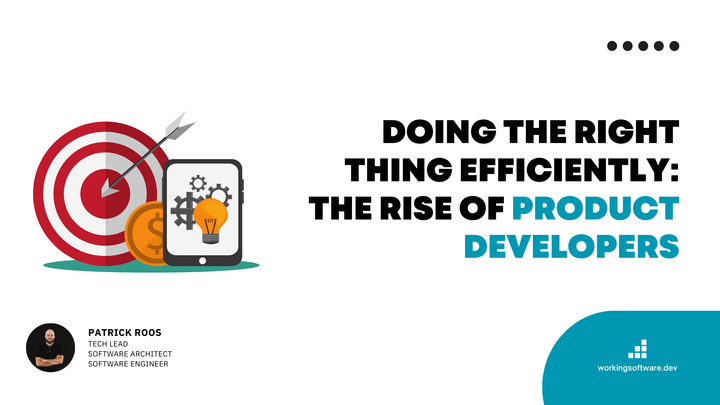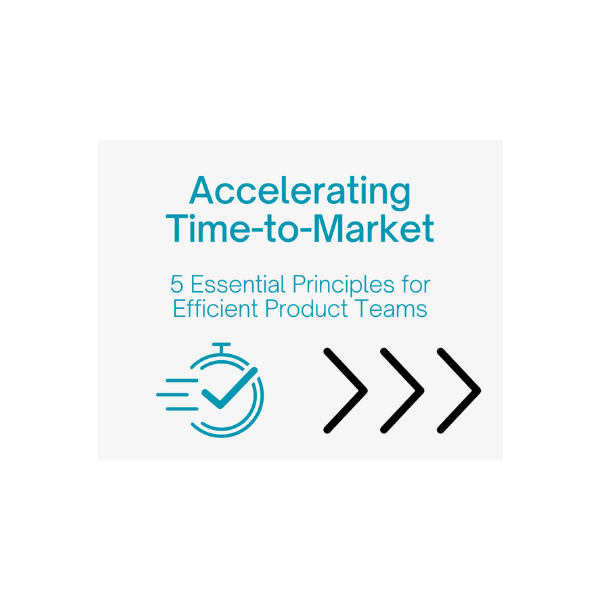9 Simple Yet Powerful Principles for Building Strong Product Teams
Building strong product teams drives software success. Learn 9 proven principles to boost trust, autonomy, and collaboration for lasting impact.

Building a high-performing product team is essential to delivering working software and ensuring the success of a commercially oriented software product company.
It's a goal that every owner, CEO, CIO and CTO shares.
Over the past 15 years, I have had the privilege of helping numerous CEOs, CIOs and CTOs build effective and sustainable software product teams.
Some approaches have delivered outstanding results, while others have been valuable learning experiences.
In this post, I share the principles that have proven successful in building productive and successful product teams.
While these principles may seem simple, they are often overlooked — yet they are critical to success.
TL;DR 👇
- #1 Build Teams Around Business Outcomes, Not Technical Silos
- #2 Start Small, Evolve the Product Team Over Time
- #3 Hire for Cultural Fit, Not Just for the Technical Fit
- #4 Let Teams Choose Their Tools and Platforms
- #5 Strive for Long-Term Static Teams
- #6 Give Everyone a Strong Voice
- #7 Provide a Strong Product Vision and Purpose
- #8 Build Good Relationships Beyond Work
- #9 Encourage Willing Team Members
#1 Build Teams Around Business Outcomes, Not Technical Silos
Organising teams around business aspects rather than technical silos ensures a stronger focus on the end user experience.
In a previous software initiative, the teams were organised according to aspects such as: Frontend, Backend, Infrastructure and Design.
We transformed the teams into cross-functional, business-specific teams: Business aspects such as: Order Team, Payment Team, Catalogue Team, ... Each of these teams has its own employees who take on E2E responsibility and give them autonomy.
This reduced the coordination effort and impressively increased the productivity of the teams.
#2 Start Small, Evolve the Product Team Over Time
When you start a product initiative, one trap is to hire a lot of engineers right at the beginning.
This won't work or is rather ineffective in the known team building phases (Forming, Storming, Norming, Performing).
The larger the team, the longer these team development phases take. So start small, build a healthy core and develop the product team over time.
In a previous software initiative, the original intention was to start a big product initiative and hire a lot of people at the beginning.
A manager once called: "We need at least 30 full-time employees to build this product! We need to hire them now!" The manager was probably right about the number of employees needed for the final product team... but there is a "but".
But instead of investing a lot of money and effort in hiring and organising people at the beginning, we put together a small cross-functional team to start with the initial business aspects. This helped us get started with product development and build good relationships with stakeholders.
Once the small product team was working well, we recruited other like-minded people and over time built a strong, good and healthy product team that grew successfully over time.
This approach helps us to move forward with a continuous minimal-storming phase of the product and continuously deliver software products.
#3 Hire for Cultural Fit, Not Just for the Technical Fit
Skills can be taught, but culture determines how a team works together and thrives.
Look for candidates who align with the team's values and work style. This fosters a harmonious and motivated environment.
During a product initiative, we received many applications with many highly qualified software engineers. One software engineer has an impressive technology portfolio. Even in the interview, he seems to be an expert in the technologies we are looking for.
When asked how he will behave in a situation where there are differing opinions on a architecture choice, he replied: "I will show them that my choice is always the right one."
For me, this candidate was the right one in terms of tech skills, but not in terms of culture. In our case, the evaluation and alignment of technologies and the resulting architecture decisions are a team effort, and it's important that the architecture and technology decisions are aligned within the product team.
Rude and bossy behavior by individual team members at this level diminishes team spirit and promotes conflict within the team.
In my opinion, you should be extremely careful when hiring employees. Prioritize cultural fit over technical fit. Technical skills are often easy to learn, but soft skills are hard to learn.
#4 Let Teams Choose Their Tools and Platforms
If you hire a handyman to repair something in your house, he'll always bring his own tools. You can't tell him what tools to bring. Or at least that's not what you want.
Empower your product teams to make decisions about tools, technologies and platforms. Trust their expertise and give them autonomy. If you don't trust these people, you have the wrong people in place.
This not only strengthens their sense of responsibility, but also often leads to more innovative and effective solutions.
In my last 15 years of building product teams, I have so many examples where special technical constraints reduces team performance and the intrinsic motivation of the team members a lot.
One interesting example was a constraint to use a special model driven object relational mapper which was defined by the former CTO.
Nobody of the teams except the inventor (a costlier consultant) knew something about this model driven orm.
Documentation was also pretty skinny. But the team was forced to use this framework to implement all business functionalities. This demotivates the most of the team members a lot, each team member points to this constraint regarding team performance.
As part of a turnaround management initiative, we could remove these crappy constraints and upgrade appropriate technologies for our real problems and significantly increase the productivity of the team and the commitment of each individual team member.
#5 Strive for Long-Term Static Teams
Minimize the shifting of team members in and out of product teams. Strive for long-term static product teams. Try to reject any initiative for personal pooling.
Long-term static teams build trust, rhythm and understanding, which are essential for productivity and innovation.
In a previous project, our team worked on a marketing analytics platform. Halfway through the mvp development, management decided to reassign a backend developer of our product team to a new high-priority initiative with the expectation that he would be able to complete both tasks efficiently.
Almost immediately, the first cracks began to appear. Progress on the analytics platform slowed dramatically as the remaining team struggled without the backend developer's expertise. At the same time, the new software initiative was delayed as the developer took weeks to familiarize himself with the unfamiliar requirements.
In the end, neither initiative was able to meet its deadline. The team's morale plummeted as they felt unsupported and management faced frustration from stakeholders.
This experience underlines the value of stable teams — pooling resources may seem efficient on paper, but in practice it disrupts trust, focus and productivity.
#6 Give Everyone a Strong Voice
Create an environment where every team member’s voice is valued and influential, regardless of their experience or title.
Diverse perspectives lead to better decisions and a sense of shared responsibility.
During a feature refinement meeting, most of the discussion was dominated by senior engineers proposing complex solutions. The product manager noticed this and explicitly invited everyone to contribute, emphasizing that all ideas were welcome.
A UX designer, who normally focuses on visual design, suggested a change to the user flow that drastically simplified the feature. The idea, which was initially overlooked, gained traction after further discussion as it addressed both technical and user-related challenges.
This moment highlighted how valuable different perspectives are, regardless of role or title. By fostering an inclusive environment, we not only found an innovative solution, but also strengthened team cohesion and mutual respect.
#7 Provide a Strong Product Vision and Purpose
Teams work best when they are inspired by a shared vision and a common goal.
Combine this with clear, achievable goals to ensure alignment and motivation.
In one of my experiences working with a SaaS company, we were driven by a vision to create a platform that enable individuals and teams to work smarter, faster, and more collaboratively.
This vision was not just a statement—it was a guiding principle that inspired us to build a intuitive, flexible platform that genuinely improved how people worked together.
To ensure alignment and motivation across the teams, we set clear, outcome-oriented goals.
For example, one quarter, we aimed to "reduce user churn by 10% by making the onboarding process seamless and engaging for new users."
This goal provided a tangible outcome for every team member to contribute toward, whether through redesigning the onboarding flow, creating engaging tutorials, or implementing personalized welcome messages.
By tying our everyday efforts to a meaningful vision and actionable goals, we created a sense of shared purpose that energized the team. This clarity not only resulted in a significant increase in user retention but also strengthened our collective commitment to delivering impactful solutions that empowered our users.
#8 Build Good Relationships Beyond Work
Maintaining personal relationships within teams is key to building trust and friendship, which ultimately fosters professional collaboration. Socialising outside of work creates the foundation for stronger relationships that translate into more effective teamwork.
As someone who values relationships and teamwork, I’ve found that a mix of remote working and regular face-to-face meetings is the perfect balance for a company that relies on remote working. In my previous team, we met every three weeks in a central location and were able to seamlessly combine focused collaboration and social activities.
These meetings were not just about work, but also about deepening relationships. A typical day consisted of brainstorming or strategy sessions, followed by social activities such as dinners together, hikes or even football games. These moments broke down barriers, created shared experiences and significantly strengthened our virtual collaboration.
This rhythm of regular face-to-face meetings has fundamentally changed the way we work together. When we are back online, the effect is unmistakable: We communicate more openly, collaborate more easily and have a stronger sense of purpose. For me, these meetings are not only valuable, but essential to maintain a thriving remote-first culture.
#9 Encourage Willing Team Members
Support and recognise people who want to develop, learn and contribute more to the team.
Encouraging initiative boosts team morale and innovative power of the team.
During a sprint review, a team member presented a prototype he had developed to improve the onboarding experience. The initiative was recognized and time was scheduled in the next sprint to check the feasibility with the entire team.
The team worked collaboratively, providing feedback and refining the idea under the guidance from experienced colleagues to ensure it aligned with the product vision. Later, the work was presented at the weekly company meeting to emphasize the value of such contributions.
This recognition sparked a wave of creative energy and other team members felt inspired to share and develop their ideas further. Supporting individual initiatives in this way not only boosted team morale, but also led to tangible improvements to the product and processes and strengthened the company’s culture of innovation.
Wrapping Up
Building great product teams is as much about principles as it is about continuous learning.
When you focus on fostering trust, autonomy, purpose and shared responsibility, you lay a solid foundation for sustainable success.
These principles have guided me along the way, and I hope they are useful for you too.



Comments ()